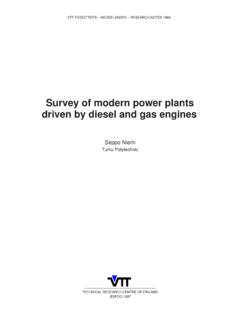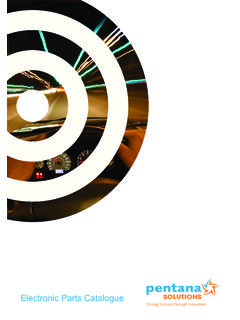Transcription of PAH CONTENT OF DIESEL FUEL AND AUTOMOTIVE …
1 RESEARCH REPORT No VTT-R-1155-06 PAH CONTENT OF DIESEL FUEL AND AUTOMOTIVE EMISSIONS Authors P ivi Aakko, Tiina Harju, Markku Niemi, Leena Rantanen-Kolehmainen Confidentiality: Public RESEARCH REPORT VTT-R-1155 06 2 (50) Abstract The harmfulness of polyaromatic hydrocarbons (PAH) in DIESEL fuel has been well evidenced in past. This has lead to limit value of PAH CONTENT of DIESEL fuel in Europe (Directive 2003/17/EC, PAH di+ max.)
2 11 wt%). In Sweden, more stringent limit value is applied for reformulated DIESEL fuel, and in Finland, before 2004, a tax incentive was given to DIESEL fuel fulfilling limits for certain properties, for total aromatics. Recent studies on the effect of fuel aromatics on the PAH emissions have focused on light-duty cars. However, it is important to study the relationship between fuel and exhaust PAHs also with the modern heavy-duty engines/vehicles in real life conditions using transient test cycles.
3 This study on the influence of polyaromatic hydrocarbons of DIESEL fuel on the PAH emissions was conducted in programme funded by National technology Agency of Finland (Tekes), Neste Oil, VTT Processes and Ministry of the Environment. Two DIESEL fuels were studied, one with polyaromatic CONTENT of 1 wt% (di+) and the other with polyaromatic CONTENT of 5 wt%. The tests were carried out using six DIESEL technologies: Euro 2 heavy-duty engine, Euro 3 bus without catalyst, Euro 3 bus with oxidation catalyst, Euro 4 truck equipped with particle oxidation catalyst and two passenger cars (common-rail and TDI).
4 Euro 2 engine was tested using the steady-state cycle, and the heavy-duty and light-duty vehicles using transient cycles on chassis dynamometer. A set of polyaromatic hydrocarbons (PAHs) was analyzed from the soluble organic fraction of particulate matter. Mutagenicity of particulate extracts was studied with Ames-test. CO and HC emissions were low for the tested DIESEL applications. No significant difference between the two fuels studied was seen for CO emission.
5 HC emission was lower with fuel containing less aromatics. NOx emissions from heavy-duty applications were around 5% lower with the fuel containing less aromatics, but no difference was seen for the cars. PM emission was slightly reduced when aromatic CONTENT of fuel was decreasing with the other applications than Euro 3 bus engine. In the tests with catalyst, the particles were rather dry (10-20% SOF), whereas with Euro 3 bus without catalyst wet (40% SOF). Sum of seven priority PAH compounds showed systematic benefit for lower polyaromatic CONTENT of fuel despite of very low PAH emission level.
6 The PAH emissions were 20-80% lower for the fuel containing 1 wt% of PAHs than for the fuel containing 5 wt% of PAHs with major part of DIESEL applications studied. However, for the Euro 4 truck the PAH emission level was too low to draw conclusions. Ames test showed same trend as PAH results. Significant benefit of reducing polyaromatic CONTENT of fuel was seen with all DIESEL applications studied. Even with the Euro 4 truck equipped with the particle oxidation catalyst, for which almost no priority PAHs was observed, a substantial benefit of lower polyaromatic CONTENT of DIESEL fuel was evident in the Ames test.
7 This study showed the significance of polyaromatic CONTENT of DIESEL fuel in reducing harmfulness of the exhaust emissions from modern heavy-duty and light-duty DIESEL engine/vehicles with or without catalysts. Significant benefit was obtained particularly as concerns PAHs associated with particles, and Ames mutagenicity of particulate extract. However, no exact limit for polyaromatic CONTENT can be recommended based on this study. In addition, some open questions remain, like the performance at cold ambient temperatures.
8 RESEARCH REPORT VTT-R-1155 06 3 (50) Preface In Finland, the influence of polyaromatic hydrocarbons in DIESEL fuel on the PAH emissions from engines and vehicles was studied from June 2005 to January 2006. Research work was divided in two parallel programs. One program was funded by Neste Oil and National technology Agency of Finland (Tekes) within the research program FINE Particles - technology , Environment and Health . Parallel project was funded by VTT Technical Research Centre of Finland and Ministry of the Environment.
9 All participants are acknowledged for funding, which enabled to conduct this interesting task. The time-frame of the project was challenging when considering the extensive CONTENT of task. This required a lot of effort, knowledge and co-operation. Thanks are given to personnel that contributed to the measurements, among these at VTT are Kimmo Erkkil , Erkki Virtanen, Reijo Mikkola, Timo Murtonen and P ivi Koponen for engine/vehicle emission tests, Marjaana R tt and Marja-Liisa Jalovaara for Ames tests.
10 In addition, thanks are given to the Nablabs laboratories, who carried out the PAH analyses. Special acknowledgement is given to Ari Juva and Seppo Mikkonen from Neste Oil for their valuable input and comments. Espoo, Authors RESEARCH REPORT VTT-R-1155 06 4 (50) Contents 1 Abbreviations 5 2 Introduction 6 3 Background 7 DIESEL particles 7 DIESEL exhaust 7 Formation of particles 10 Composition of particles 12 Polyaromatic hydrocarbons 14 Mutagenicity 18 Definition and determination 18 Mutagenicity of DIESEL exhaust 20 PAH and mutagenicity results from DIESEL exhaust 20 PAH and mutagenicity level in DIESEL exhaust 20 The effect of different parameters 22 4 Experimental 25 Test fuels.














